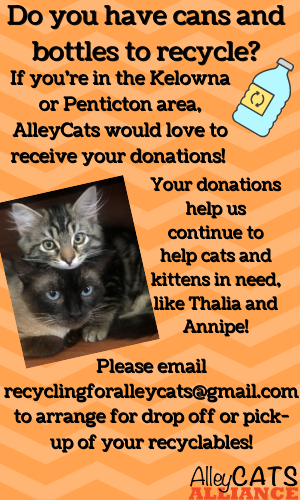Trap, Neuter, Release – How To . . .
What is Trap, Neuter, Release?
Trap: Humanely trap all of the cats in a colony (a group of cats living outdoors together).
Neuter: Take the cats in their traps to a veterinarian or clinic to be neutered, vaccinated, and ear-tipped (a universal symbol indicating they have been neutered).
Release: Return the cats to their original outdoor home.
Important things to note:
- Only use a humane box trap to trap a feral cat. Never use darts or tranquillizers to attempt to catch a cat. These methods are dangerous and stressful for the cats. Nets are also not recommended for the same reasons.
- NEVER attempt to pick up a feral cat, particularly to put her in a carrier or trap. No matter how sweet she seems, handling a cat who has never—or not recently—been touched will frighten and stress her. She may struggle to get away and harm you in the process. With no vaccination records, she is bound to be killed or put into quarantine. Use the correct trapping practices to ensure the safety of both you and the cat.
- Keep in mind that your trapping will be most effective if you employ targeted trapping, which is a trapping approach that allows for complete results.
- Feral cats are fearful of people in general. This fact should influence every choice you make when trapping. They may feel even more frightened and threatened when faced with a new experience, like being trapped and transported to a veterinarian. This is true for cats who normally act docile around their caregivers as well. Feral cats will not communicate their needs (if they are hurt, in pain, or frightened). Instead, they will thrash about when in their carriers or they may simply “shut down.” It is essential that you stay quiet, calm, and conscious of the cats’ well-being during your trapping ventures.
- No trapping effort is exactly the same. A colony’s location—a college campus, a warehouse, a farm, an alley, a small business parking lot— will have unique elements for you to consider. Use your discretion to determine any additional steps to those provided in this guide, and tailor the basics to fit your colony’s situation. For instance, you may need to work with college administrators, connect with other caregivers, or ensure you have enough traps and vehicles for a large colony.
Taking on a colony requires a very detailed plan – please ensure that you have contacted a group with the experience and knowledge to plan it out.
You will need to:
- Find and coordinate with the other caregivers about your plans to trap
- Communicate with neighbours around the colony
- Have the equipment and a team to undertake trapping
- Have a veterinarian in place to assess the cats
- Have a recovery and holding area after surgery for 3 – 10 days
- Archive which animals have been altered
- Monitor for new births in case animals join the colony, or you have missed some in trapping
You will need to be prepared for those special scenarios such as illness or injury, pregnant mothers, and social animals that need to be placed in homes. This is a big undertaking that you can assist with and make a difference in your community if you can pull all of the details together.


